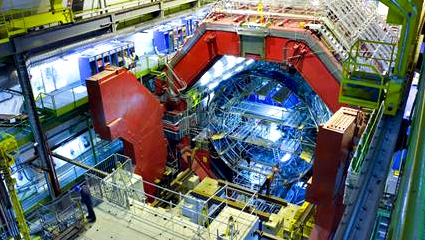
Last week, the world’s most powerful particle accelerator began its second act. After two years of upgrades and repairs, proton beams once again circulated around the Large Hadron Collider (LHC), located at the CERN laboratory near Geneva (pictured).
With the collider back in action, more than 1,700 U.S. scientists — including two Wayne State University teams — are prepared to join their international colleagues to study the highest-energy particle collisions ever achieved in the laboratory.
These collisions – hundreds of millions of them every second – will lead scientists to new and unexplored realms of physics, and could yield extraordinary insights into the nature of the physical universe.
A highlight of the LHC’s first run was the discovery of the Higgs boson in 2012. The Higgs boson is the last in the suite of elementary particles that make up scientists’ best picture of the universe and how it works.
Wayne State’s involvement with the LHC project includes scientists serving on two teams called ALICE and CMS. The ALICE collaboration involves 1,500 physicists from 37 countries, and includes WSU physics professors W.J. Llope, Claude Pruneau, Joern Putschke, Rossi Reed and Sergei Voloshin.
“Wayne State has contributed to the construction of a large detector component known as the electromagnetic calorimeter, and members of our group are now actively involved in the operation of the experiment and the analysis of the data it has collected over recent years,” said Pruneau.
The data volume collected by ALICE amounts to petabytes (one petabyte is 1 million gigabytes), and the analysis is carried out using the ALICE Grid involving large computing facilities all around the world. Data taken during the next run will enable the collaboration to study fundamental proton-proton collisions at unprecedented energy.
“The ALICE collaboration is interested in understanding the behavior of matter produced in proton-proton collisions at such high energy. Does it flow like a fluid or does it behave as a gas of particles? Can one demonstrate the existence of collective motion or flow in these collisions?” said Pruneau.
The CMS team, composed of 3,000 scientists from 38 countries, investigates the nature of matter and energy at the smallest possible scales and largest possible energies. Wayne State’s CMS team is led by physics professors Robert Harr and Paul Karchin. Other group members include Alfredo Gutierrez, research engineer, Jared Sturdy, postdoctoral fellow, and five graduate students — Christopher Clarke, Nabin Poudyal, Kevin Siehl, Shawn Zaleski and Prakash Thapa.
The WSU team contributes to the endcap muon system of the detector, and is involved in the development of new gas electron multiplier detectors to enhance the performance of the detector. Researchers are looking for signs of new particles or interactions that may decay to pairs of particles called muons, or produce subtle changes in the behavior of weak bosons.
For more information on the U.S. role in the Large Hadron Collider, visit this website: uslhc.web.cern.ch.
